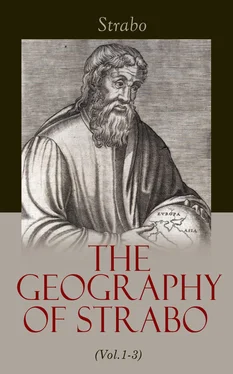Strabo - The Geography of Strabo (Vol.1-3)
Здесь есть возможность читать онлайн «Strabo - The Geography of Strabo (Vol.1-3)» — ознакомительный отрывок электронной книги совершенно бесплатно, а после прочтения отрывка купить полную версию. В некоторых случаях можно слушать аудио, скачать через торрент в формате fb2 и присутствует краткое содержание. Жанр: unrecognised, на английском языке. Описание произведения, (предисловие) а так же отзывы посетителей доступны на портале библиотеки ЛибКат.
- Название:The Geography of Strabo (Vol.1-3)
- Автор:
- Жанр:
- Год:неизвестен
- ISBN:нет данных
- Рейтинг книги:3 / 5. Голосов: 1
-
Избранное:Добавить в избранное
- Отзывы:
-
Ваша оценка:
- 60
- 1
- 2
- 3
- 4
- 5
The Geography of Strabo (Vol.1-3): краткое содержание, описание и аннотация
Предлагаем к чтению аннотацию, описание, краткое содержание или предисловие (зависит от того, что написал сам автор книги «The Geography of Strabo (Vol.1-3)»). Если вы не нашли необходимую информацию о книге — напишите в комментариях, мы постараемся отыскать её.
The Geography of Strabo (Vol.1-3) — читать онлайн ознакомительный отрывок
Ниже представлен текст книги, разбитый по страницам. Система сохранения места последней прочитанной страницы, позволяет с удобством читать онлайн бесплатно книгу «The Geography of Strabo (Vol.1-3)», без необходимости каждый раз заново искать на чём Вы остановились. Поставьте закладку, и сможете в любой момент перейти на страницу, на которой закончили чтение.
Интервал:
Закладка:
4. Pherecydes appears to have given to Gades the name of Erythia, the locality of the myths concerning Geryon: others suppose it to have been the island situated near to this city, and separated from it by a strait of merely one stadium. This they do on account of the excellence of its pasturage. For the milk of the cattle which feed there does not yield any whey, and they are obliged to mix it with large quantities of water when they make cheese on account of its richness. After fifty days the beasts [pasturing there] would be choked unless they were let blood. The pasturage of the country is dry, but it fattens wonderfully: and it is thought that from this the myth concerning the oxen of Geryon took its rise. The whole sea-shore however is possessed in common. 1282
5. Concerning the foundation of Gades, the Gaditanians report that a certain oracle commanded the Tyrians to found a colony by the Pillars of Hercules. Those who were sent out for the purpose of exploring, when they had arrived at the strait by Calpe, imagined that the capes which form the strait were the boundaries of the habitable earth, as well as of the expedition of Hercules, and consequently they were what the oracle termed the Pillars. They landed on the inside of the straits, at a place where the city of the Exitani now stands. Here they offered sacrifices, which however not being favourable, they returned. After a time others were sent, who advanced about 1500 1283stadia beyond the strait, to an island consecrated to Hercules, and lying opposite to Onoba, a city of Iberia: considering that here were the Pillars, they sacrificed to the god, but the sacrifices being again unfavourable, they returned home. In the third voyage they reached Gades, and founded the temple in the eastern part of the island, and the city in the west. On this account some consider that the capes in the strait are the Pillars, others suppose Gades, while others again believe that they lie still farther, beyond Gades. There are also some who think that the Pillars are Calpe, 1284and the mountain of Libya which is opposite, named Abilyx, 1285and situated, according to Eratosthenes, amongst the Metagonians, a wandering race. Others fancy that they are two small islands near to the former, one of which is named the Island of Juno. Artemidorus speaks both of the Island of Juno and the temple there, but makes no mention either of mount Abilyx, or the nation of [Pg 256] [CAS. 170] the Metagonians. 1286Some have transported hither the Planctæ and the Symplegades, supposing them to be the Pillars, which Pindar calls the Gates of Gades, when he says that they were the farthest limits at which Hercules arrived. 1287Dicæarchus, Eratosthenes, and Polybius, with most of the Grecians, represent the Pillars as being close to the strait, while the Iberians and Libyans place them at Gades, alleging that there is nothing at all resembling pillars close by the strait. Others pretend that they are the pillars of brass eight cubits high in the temple of Hercules at Gades, on which is inscribed the cost of erecting that edifice; and that the sailors coming there on the completion of their voyage and sacrificing to Hercules, rendered the place so famous that it came to be regarded as the termination of the land and sea. Posidonius thinks this view the most probable of all, and looks upon the oracle and the several expeditions as a Phœnician invention. 1288As for the expeditions, what matters it whether any one should vehemently deny or credit the account, as neither the one nor the other would be inconsistent with reason: but the assertion that neither the little islands, nor yet the mountains, bear much resemblance to pillars, and that we should seek for pillars, strictly so called, [set up] either as the termination of the habitable earth, or of the expedition of Hercules, has at all events some reason in it; it being an ancient usage to set up such boundary marks. As for instance the small column which the inhabitants of Rhegium 1289erected by the Strait of Sicily, which is indeed a little tower; and the tower called after Pelorus, which is situated opposite to this small column; also the structures called altars 1290of the Philæni, about midway in the land between the Syrtes; likewise it is recorded, that a certain pillar was formerly erected on the Isthmus of Corinth, which the Ionians who took possession of Attica and Megaris when they were driven out of the Peloponnesus, and those who settled in the Peloponnesus, set up in common, and inscribed on the side next Megaris,
“This is no longer Peloponnesus, but Ionia;”
and on the opposite,
“This is Peloponnesus, not Ionia.”
Alexander too erected altars as boundaries of his Indian campaign in those parts of the Indies he arrived at, which were situated farthest towards the east, in imitation of Hercules and Bacchus. 1291That this custom existed, then, cannot be doubted.
6. It is probable that the places themselves took the same name [as the monuments], especially after time had destroyed the boundary marks which had been placed there. For instance, at the present day the altars of the Philæni no longer exist, but the place itself bears that designation. Similarly they say that in India neither the pillars of Hercules or Bacchus are to be seen, nevertheless certain localities being described and pointed out to the Macedonians, they believed that those places were the pillars in which they discovered any trace either of the adventures of Bacchus or Hercules. In the instance before us, it is not improbable that they who first [visited these regions], set up boundary marks fashioned by the hand of man, such as altars, towers, and pillars, in the most remarkable situations, to indicate the farthest distance they had reached, (and straits, the surrounding mountains, and little islands, are indubitably the most remarkable situations for pointing out the termination or commencement of places,) and that after these human monuments had decayed, their names descended to the places [where they had stood]; whether that were the little islands or the capes forming the strait. This latter point it would not be easy now to determine; the name would suit either place, as they both bear some resemblance to pillars; I say bear some resemblance, because they are placed in such situations as might well indicate boundaries. Now this strait is styled a mouth, as well as many others, but the mouth is at the beginning to those sailing into the strait, and to those who are quitting it at the end. The little islands at the mouth having a contour easy to describe, and being remarkable, one might not improperly compare to pillars. In like manner the mountains overlooking the strait are prominent, [Pg 258]
[CAS. 172] resembling columns or pillars. So too Pindar might very justly have said, “The Gaditanian Gates,” if he had in mind the pillars at the mouth; for these mouths are very similar to gates. On the other hand, Gades is not in a position to indicate an extremity, but is situated about the middle of a long coast forming a kind of gulf. The supposition that the pillars of the temple of Hercules in Gades are intended, appears to me still less probable. It seems most likely that the name was originally conferred not by merchants, but generals, its celebrity afterwards became universal, as was the case with the Indian pillars. Besides, the inscription recorded refutes this idea, since it contains no religious dedication, but a mere list of expenses; whereas the pillars of Hercules should have been a record of the hero’s wonderful deeds, not of Phœnician expenditure.
7. Polybius relates that there is a spring within the temple of Hercules at Gades, having a descent of a few steps to fresh water, which is affected in a manner the reverse of the sea-tides, subsiding at the flow of the tide, and springing at the ebb. He assigns as the cause of this phenomenon, that air rises from the interior to the surface of the earth; when this surface is covered by the waves, at the rising of the sea, the air is deprived of its ordinary vents, and returns to the interior, stopping up the passages of the spring, and causing a want of water, but when the surface is again laid bare, the air having a direct exit liberates the channels which feed the spring, so that it gushes freely. Artemidorus rejects this explanation, and substitutes one of his own, recording at the same time the opinion of the historian Silanus; but neither one or other of their views seems to me worth relating, since both he and Silanus were ignorant in regard to these matters. Posidonius asserts that the entire account is false, and adds that there are two wells in the temple of Hercules, and a third in the city. That the smaller of the two in the temple of Hercules, if drawn from frequently, will become for a time exhausted, but that on ceasing to draw from it, it fills again: while in regard to the larger, it may be drawn from during the whole day; that it is true it becomes lower, like all other wells, but that it fills again during the night when drawing ceases. [He adds] that the ebb tide frequently happening to occur during the period of its re-filling, gave rise to the groundless belief of the inhabitants as to its being affected in an opposite manner [to the tides of the ocean]. However it is not only related by him that it is a commonly believed fact, but we have received it from tradition as much referred to amongst paradoxes. 1292We have likewise heard that there are wells both within the city and also in the gardens without, but that on account of the inferiority of this water, tanks are generally constructed throughout the city for the supply of water: whether likewise any of these reservoirs give any signs of being affected in an opposite manner to the tides, we know not. If such be the case, the causes thereof should be received as amongst phenomena hard to be explained. It is likely that Polybius may have assigned the proper reason; but it is also likely that certain of the channels of the springs being damped outside become relaxed, and so let the water run out into the surrounding land, instead of forcing it along its ancient passage to the spring; and there will of course be moisture when the tide overflows. 1293But if, as Athenodorus asserts, the ebb and flow resemble the inspiration and expiration of the breath, it is possible that some of the currents of water which naturally have an efflux on to the surface of the earth, through various channels, the mouths of which we denominate springs and fountains, are by other channels drawn towards the depths of the sea, and raise it, so as to produce a flood-tide; when the expiration is sufficient, they leave off the course in which they are then flowing, and again revert to their former direction, when that again takes a change. 1294
Читать дальшеИнтервал:
Закладка:
Похожие книги на «The Geography of Strabo (Vol.1-3)»
Представляем Вашему вниманию похожие книги на «The Geography of Strabo (Vol.1-3)» списком для выбора. Мы отобрали схожую по названию и смыслу литературу в надежде предоставить читателям больше вариантов отыскать новые, интересные, ещё непрочитанные произведения.
Обсуждение, отзывы о книге «The Geography of Strabo (Vol.1-3)» и просто собственные мнения читателей. Оставьте ваши комментарии, напишите, что Вы думаете о произведении, его смысле или главных героях. Укажите что конкретно понравилось, а что нет, и почему Вы так считаете.












![Anne Blunt - A Pilgrimage to Nejd, the Cradle of the Arab Race. Vol. 2 [of 2]](/books/750183/anne-blunt-a-pilgrimage-to-nejd-the-cradle-of-the-thumb.webp)